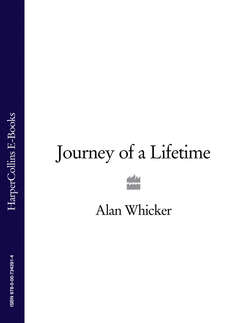Читать книгу Journey of a Lifetime - Alan Whicker - Страница 11
7 NO ONE CARED ENOUGH
ОглавлениеThey were the generation of women who went into the ’39 war and came out at the other end, unscathed but changed. Well-mannered, well-dressed, determined and resourceful, the Scarlett O’Haras of the post-war years. Brought up expecting to live the opulent lives of their parents, they were aware such a world no longer existed, so, instead of clinging to the past, they reinvented themselves and became the bridge between Mrs Miniver and The Beatles.
Edana Romney was South African, creamy-skinned and red-haired. In the late 40s she starred in films, notably Corridor of Mirrors—remembered fondly by film aficionados for her endless close-ups. It was directed by a youthful Terence Young, who went on to tackle various James Bonds. She was married to John Woolf who, with his mischievous brother Jimmy, dominated much of the British film industry in the Fifties and Sixties—John a producer of significance, Jimmy a powerful agent and lover of Laurence Harvey.
Pictures of Edana show her in billowing evening dresses, waist cinched, a glittering show-business figure in a drab time of rationing and clothing coupons. All plain sailing until her marriage ended. Abruptly she did another Scarlett and began a new career in a new medium: she became BBC television’s first agony aunt, with Edgar Lustgarten.
She moved into a stylish flat overlooking Hyde Park, rented Rose Cottage on the D’Avigdor Goldsmith estate near Tonbridge, and settled down with her elegant mother Min and Freddie the butler. It was an eccentric, stylish ménage that would survive some forty years of adventures on both sides of the Atlantic.
Chintzy Rose Cottage was transplanted lock, stock and steaming crumpets to San Ysidro Drive, a charming house in Beverly Hills, then to Summitridge, once home of Corbina Wright, a notorious gossip columnist. They lived well, though by Hollywood standards frugally.
None of them had ever given a thought to driving a car—so here in California, where only the criminal or the eccentric actually walk anywhere, they lived in grand isolation. Connected to the world only by an overworked telephone, Edana settled down to a new career as a writer.
She had fallen in love with Richard Burton. Not Burton of the velvet voice and Elizabeth Taylor, but Burton the nineteenth-century adventurer and explorer. He translated the Kama Sutra, wrote about and patronized male brothels and polygamous Mormons and, risking death, coloured his skin for a forbidden visit to Mecca, Islam’s most holy place.
For Edana it was almost an eighteenth-century life. She would stay in her boudoir most of the morning on the phone to friends, handing out advice and dreaming dreams of the dashing Burton. She wrote and rewrote her screenplay in a book annotated with ideas for location, strips of fabric for costumes and grand delusions: Sean Connery would play Burton, Richard Attenborough would direct. Someone once suggested that Tom Stoppard might rewrite the script. “Tom who?” she said, grasping the project ever closer to her. She forgot that Hollywood promises have a shorter life than celluloid kisses.
Over the years, many years, Burton became an obsession. To finance her dream she visited the Sahara, courted the sheikhs of the Gulf and the Ivory Coast, mortgaged her home and her life and finally—lost everything.
The Manson murders terrified Hollywood but brushed lightly past Edana. Every high-profile actor expected to be shot or kidnapped any day, but Edana and I were invited to a party at the home of Joan Cohn, the movie mogul’s widow and a major figure in Beverly Hills. It was an A-list party which would surely overcome the fears of the most macho film stars—indeed most of the great and the good in the film world wereon parade.
